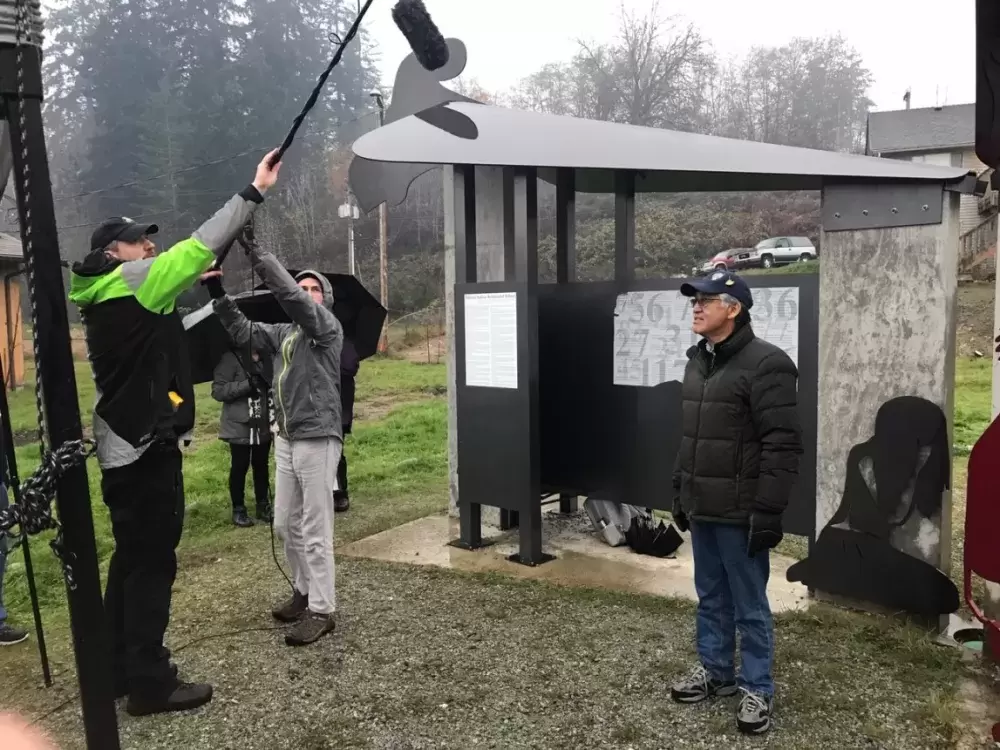Alberni Indian Residential School survivors and former students of art teacher Robert Aller gathered in Port Alberni for two days in November for the production of a video that tells stories about connections to their land.
The project is part of a reconciliation effort involving the Canadian Museum of History in Ottawa and the repatriated paintings that were made by the survivors nearly 60 years ago, when there were at AIRS.
Mr. Robert Aller taught extracurricular art classes at the Alberni Indian Residential School between the years of 1959 and 1964. He was living in Port Alberni at the time and taught art as a volunteer. His teaching style focused on technique while allowing children to explore their creativity. He taught the children how to paint, not what to paint.
They responded by choosing subject matter that was near and dear. Many chose images of home or of wildlife, people and places.
They probably would have never had another thought of their childhood paintings were it not for the thoughtful Aller family, who donated the 700-plus paintings that Aller collected and saved to the University of Victoria Legacy Art Galleries following his death in 2008.
Most of the paintings were made by other students in other residential schools, but some came from his time at AIRS. UVic staff were able to locate many of the survivors of the signed paintings.
The collection was shown at a TRC regional event in Victoria in 2012. During that time UVic staff worked on establishing culturally appropriate protocols for returning the paintings to the original owners.
In Mar. 2013 a large event was held and the paintings were given back to the original artists. In most cases, the survivors received framed replicas so that the delicate newsprint paintings that were more than 60 years old could be safely stored.
In 2017 the Canadian Museum of History opened its new Canada Hall wing, featuring the AIRS survivor’s art as an exhibit, a show of Canada’s reconciliation effort. Visiting schools regularly tour the museum and often take part in learning exercises after a tour. The museum must have prepared learning activities for this purpose.
So artists Carey Newman and Kelly Richardson were hired to develop materials as part of the museum’s education program for the exhibit. They, along with Dr. Andrea Walsh and the group of artist survivors, spent two days in rainy Port Alberni reconnecting and shooting video for the educational portion of the exhibit.
“We recorded stories and memories of the lands and waters that were home to the children who attended residential school and we hope those stories will be compelling ways to understand why land is so important to reconciliation today,” Walsh said.
She said the video portion of the work helps to bring the human aspect forward.
The Canadian Museum of History opened its new Canadian History Hall on Jul. 1, 2017. According to Walsh, Gallery 3 is dedicated to contemporary Canadian history and includes Indian Residential Schools.
The artwork of the AIRS survivors has been made into a permanent exhibit at Canada Hall. They have already made recordings to tell their stories as an accompaniment to their paintings. Now they are assisting in the development of teaching materials and an educational component to the exhibit.
According to Walsh, after the school students tour the museum they spend two hours on an education unit provided by the museum to reinforce their learning experience.
The new round of filming will provide materials needed for the development of a teaching feature at the museum. Artists Carey Newman and Kelly Richardson were hired to develop the new feature.
Walsh, who has been involved with the repatriation of the artwork made by AIRS survivors, says the project is intended to be a story of reconciliation that will play to both a national and international audience.
An intergenerational survivor, Newman is known for creating The Blanket, a 40-foot wooden mosaic exhibit that contains snapshots of Indian Residential Schools, from a child’s shoe to a door from an actual school. The Blanket delivers a poignant view of the residential schools from a First Nations perspective.
“The blanket is a universal symbol of protection. For many of us, it identifies who we are and where we’re from – we wear them in ceremony and give them as gifts.
Blankets protect our young and comfort our elders,” said Newman.
Newman’s next project with the Canadian Museum of History is to create an art activity for school students that teaches the history of residential schools and the concept of reconciliation.
“It has to be broader than just residential schools. It must include conversations around land,” said Walsh.
On Nov. 12 Newman was introduced to the survivors and spoke to each one about land. Each survivor shared stories about how land is meaningful to them. They were videotaped at various locations around Vancouver Island such as Polly’s Point, Stamp River and Goldstream Park. The filming produced statements from the survivors about land.
Newman expects to have his concept done by mid spring 2019.







